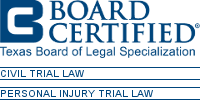THE DOCTORS’ COMPANY, AN INTERINSURANCE EXCHANGE, Appellant v. NANCY A. MCDONOUGH, Appellee
NO. 01-00-00741-CV
COURT OF APPEALS OF TEXAS, FIRST DISTRICT, HOUSTON
2002 Tex. App. LEXIS 6569
August 30, 2002, Filed
NOTICE:
[*1] PURSUANT TO THE TEXAS RULES OF APPELLATE PROCEDURE, UNPUBLISHED OPINIONS SHALL NOT BE CITED AS AUTHORITY BY COUNSEL OR BY A COURT.
PRIOR HISTORY:
On Appeal from the 80th District Court. Harris County, Texas. Trial Court Cause No. 98-50475.
DISPOSITION:
Reversed in part and affirmed in part.
JUDGES:
Panel consists of Chief Justices Schneider and Justices Jennings and Wilson. n6
n6 The Honorable Davie L. Wilson, who retired from the Court effective March 31, 2002, continues to participate by assignment.
OPINIONBY:
Michael Schneider
OPINION:
This suit arises from a health insurer’s denial of health benefits based on a “pre-existing condition” exclusion. The patient (Nancy A. McDonough) filed suit, alleging that the insurer (The Doctors’ Company, an Interinsurance Exchange): (1) breached its contract by refusing to pay medical expenses, which she incurred while undergoing cancer treatment, (2) acted in bad faith in denying coverage, and (3) misrepresented the coverage afforded by the policy. After the trial court denied the insurer’s motion for directed verdict, a jury returned a verdict for the patient, and the trial court entered a final judgment against the insurer for $ 181,520.00, plus interest, costs, and attorney’s fees for appeal, if [*2] necessary. This appeal followed. We reverse in part and affirm in part.
Facts
In January 1997, Nancy McDonough applied for insurance with The Doctors’ Company, an Interinsurance Exchange (hereinafter, “the insurer”). McDonough needed a one year policy to apply between the date she terminated another policy and the date she became eligible for Medicare. The insurer’s policy was designed for such short-term coverage and was automatically available if the applicant met three qualifications: (1) the applicant must have had no other medical coverage; (2) neither the applicant, nor anyone in their family could be pregnant; and (3) the applicant must have been a resident of the United States for the past five years. The cost of the policy was about half that of typical major medical policies. For reasons that are unclear from the record, but not disputed on appeal, McDonough’s policy was cancelled and her premiums were refunded in April 1997. The insurer invited her to “reapply for this valuable coverage.”
On May 2, 1997, McDonough visited her physician, Dr. Kathleen Gately, about a sinus infection. At this office visit, McDonough pointed out a mass on the left side of her neck [*3] to Dr. Gately. At trial, McDonough testified about her conversation with Dr. Gately as follows:
[Defense Counsel]: Well, I’m-what I’m going to ask you to do is to look at the letter from Dr. Gately. [“]At that point she pointed out a small mass in her left neck that she has recently noticed.[“] (quoting from Dr. Gately’s letter to the insurer dated February 10, 1998).
[McDonough]: That part is true.
[Defense Counsel]: “The mass was somewhat hard in the cervical …” Did she identify the mass as being-
[McDonough]: No she did not.
[Defense Counsel]: All right. Your testimony is that she didn’t do anything?
[McDonough]: And she did not. She did not prescribe anything. She just said that maybe in the future to watch it, and maybe an ENT, ear, nose and throat doctor should take had [sic] a look at it. And at that time, I told my daughter. And she’s the one that scheduled the appointment for Dr. McDonald.
[Defense Counsel]: All right. So Dr. Gately did say an ENT should look at that?
[McDonough]: The way I recall it, I believe she did. Or we had a discussion about it. But she did not refer me to Dr. McDonald, no.
Dr. Gately, in a letter to the insurance [*4] company, described the same appointment as follows:
Ms. McDonough was seen by me on May 2, 1997 for a sinusitis. At that point she pointed out a small mass in her left neck that she had recently noticed. The mass was somewhat hard in the cervical area and, because of her history of smoking, I sent her immediately to E.N.T. where she was evaluated by Dr. Sarah McDonald. This was done on May 14, 1997.
The day after her appointment with Dr. Gately, on May 3, 1997, McDonough applied for the policy at issue in this case. The application contained the following statements:
I understand that the Company will not pay benefits for loss due to any medical condition or illness for which I or any person to be insured have received treatment in the past 24 months.
Health conditions which you may presently have (pre-existing conditions) may not be immediately or fully covered under the new policy, whereas a similar claim might have been payable under your present policy.
McDonough signed the application on May 3, and on May 6, three days after McDonough saw Dr. Gately, the policy went into effect.
The policy excluded coverage for “pre-existing conditions,” which it defined as:
(a) Symptoms [*5] that would have caused an ordinarily prudent person to seek medical advice, diagnosis, care, or treatment during the twelve (12) months immediately preceding the effective date of coverage.
(b) A condition for which medical advice, diagnosis, care, or treatment was recommended or received from a Physician during the twenty-four (24) months immediately preceding the effective date of coverage.
On May 14, eleven days after pointing out the mass in her neck to Dr. Gately and eight days after the effective date of the policy, McDonough saw Dr. Sarah McDonald, an otolaryngologist (“ENT”). Dr. McDonald did a CT scan and determined that the mass was 4-5 cm in diameter. In July, a biopsy revealed that the mass was cancerous and McDonough began treatment at M.D. Anderson Cancer Center.
McDonough filed claims under the policy for the cost of her treatment, which the insurer denied, based on the pre-existing condition exclusion. This suit followed.
Breach of Contract
In question one of the charge, the jury was asked to decide whether McDonough’s cancer was a “covered sickness” under the terms of the policy. Covered sicknesses excluded pre-existing conditions as defined by the [*6] policy. The jury responded that it was, and awarded $ 42,380.00 based upon breach of the insurance contract.
In its first issue, the insurer contends that McDonough’s cancer was, as a matter of law, a pre-existing condition, as defined by the policy. We will construe this as a challenge to the trial court’s denial of the insurer’s motion for directed verdict. [HN1] Directed verdict is proper when: (1) a defect in an opponent’s pleadings makes them insufficient to support a judgment; (2) the evidence conclusively proves a fact that establishes a party’s right to judgment as a matter of law; or (3) the evidence is insufficient to raise an issue of fact. Kenneco Energy, Inc. v. Johnson & Higgins of Tex., Inc., 921 S.W.2d 254, 259 (Tex. App.–Houston [1st Dist.] 1995), aff’d in relevant part, 962 S.W.2d 507, 41 Tex. Sup. Ct. J. 268 (Tex. 1998). Under an issue questioning the denial of a motion for directed verdict, the appellant must show that the record contains evidence establishing the movant’s position as a matter of law. Rivera v. Herndon Marine Prods., Inc., 895 S.W.2d 430, 432 (Tex. App.–Corpus Christi 1995, writ denied); Kershner v. State Bar of Tex., 879 S.W.2d 343, 346 [*7] (Tex. App.–Houston [14th Dist.] 1994, writ denied). The appropriate inquiry when the trial court refuses to grant a directed verdict is whether the evidence raises an issue for the jury. See Collora v. Navarro, 574 S.W.2d 65, 68 (Tex. 1978).
The issue in this case is not who referred McDonough to Dr. McDonald n1, but whether Dr. Gately’s statement to “maybe see an ENT” was “medical advice” within the terms of the “pre-existing clause” of the policy.
n1 Dr. Gately’s letter indicates that she referred McDonough to Dr. McDonald, while McDonough testified that her daughter recommended that she see Dr. McDonald.
In Bartlett v. Am. Republic Ins. Co., 845 S.W.2d 342, 344-348 (Tex. App.–Dallas 1992, no writ), the patient saw her doctor, who told her that she had a mass in her left breast. Id. at 344. He also told her that she should see another doctor for a mammogram to determine whether a biopsy was necessary. Id. The second doctor advised the patient to wait [*8] a year before undergoing further tests. Id. During that year, the patient obtained new insurance, which contained a “pre-existing condition clause” similar to that in this case. n2 Id. After the new policy went into effect, the second doctor performed further tests and determined that the patient had breast cancer. Id. The court held that coverage was excluded under the policy, as a matter of law, because the first doctor gave the patient “medical advice” when he recommended that she see another doctor for a mammogram. Id. at 347. “Advice” was defined as “an opinion or recommendation offered as a guide to action [or] conduct.” Id., quoting WEBSTER’S ENCYCLOPEDIC UNABRIDGED DICTIONARY OF THE ENGLISH LANGUAGE 21 (1989). The court noted that the patient’s knowledge that her condition was cancer was irrelevant under the policy. Id. at 347. The fact that she sought “medical advice” about a health condition before the effective date of the policy was sufficient to trigger the exclusion. Id. at 348. The court also noted that even though the two doctors gave differing opinions, the patient, nonetheless received medical advice. [*9] Id. at 347. “Medical advice, although conflicting, is still medical advice.” Id.
n2 The “pre-existing condition” exclusion in Bartlett provided:
PRE-EXISTING CONDITION means:
(A) the existence of symptoms which would cause an ordinarily prudent person to seek diagnosis, care or treatment within a 5 year period before the date coverage begins for a covered person; or
(B) a health condition for which medical advice was given or treatment was recommended by or received from a doctor within a 5 year period before the effective date of the coverage of a covered person.
845 S.W.2d at 346.
However, in Bartlett,the medical advice actually given was more specific–the first doctor expressly recommended that the patient see another doctor for a mammogram, and, in addition, told the patient she should consider removing the lump even if it were benign. Id. at 347-48. In this case, Dr. Gately noted the existence of the mass and then, according to McDonough’s version [*10] of the facts, rather tenuously told McDonough to “maybe watch it” or “maybe see an ENT.” As such, Dr. Gately’s statements to McDonough were equivocal, as opposed to the express, pro-active recommendation given by the doctor in Bartlett.
We agree with Bartlett that medical advice is “a recommendation offered as a guide to action.” See id. at 347. We further agree that a doctor’s recommendation that a patient seek further medical advice is, in and of itself, medical advice. n3 However, in this case, Dr. Gately’s statements to McDonough to “maybe watch it” or “maybe see an ENT” are too equivocal to constitute “medical advice,” or even a recommendation to seek further medical advice.
n3 Therefore, had the jury accepted the version of facts as set forth in Dr. Gately’s February 10, 1998 letter to the insurance company, this Court would have no difficulty in concluding that McDonough had a “condition for which medical advice … was recommended,”and concluding that coverage was excluded. See Bartlett, 845 S.W.2d at 347. However, the jury was entitled to believe McDonough’s testimony that the “advice” she received from Dr. Gately was much more equivocal than a definitive recommendation to seek further medical advice.
[*11]
Accordingly, we overrule appellant’s first issue.
Extra-Contractual Claims
McDonough also pleaded extra-contractual claims under article 21.21 of the Texas Insurance Code and the Texas Deceptive Trade Practices Act. These claims can be divided into two basic categories: (1) “bad faith” settlement practices, and (2) misrepresentations made regarding coverage. n4
n4 These issues were submitted to the jury in Questions 3 and 5, which provided:
3. Did the DOCTOR’s COMPANY AN INTERINSURANCE EXCHANGE engage in any false, misleading, or deceptive act or practice that was a producing cause of damages to NANCY MCDONOUGH?
****”False, misleading, or deceptive act or practice” means any of the following:
Representing that an agreement confers or involves right, remedies or obligations which it does not have or involve.
Answer “Yes” or “No”
ANSWER: YES
5. Did THE DOCTOR’s COMPANY AN INTERINSURANCE EXCHANGE engage in any unfair or deceptive act or practice?
“Unfair or deceptive act or practice” means any of the following:
Making or cause to be made any statement misrepresenting the terms, benefits, or advantages of an insurance policy; or
Misrepresenting to a claimant a material fact or policy provision relating to the coverage at issue; or
Failing to attempt in good faith to effectuate a prompt, fair, and equitable settlement of a claim when the insurers liability has become reasonable clear, or
Refusing to pay a claim without conducting a reasonable investigation of the claim.
Answer “Yes” or “No”
ANSWER: YES
[*12]
In its second and third issues, the insurer contends there was no evidence, or alternatively, insufficient evidence to submit the extra-contractual claims to the jury.
A. Statutory Duty of Good Faith and Fair Dealing
[HN2] Under Article 21.21 of the Insurance Code, an insurer violates its duty of good faith and fair dealing by denying or delaying payment of a claim when the insurer knew or should have known that it was reasonably clear that the claim was covered. Universal Life Ins. Co. v. Giles, 950 S.W.2d 48, 55-56 (Tex. 1997). However, an insurer does not breach its duty by delaying payment, when there is a bona fide controversy as to liability. See Provident Am. Ins. Co. v. Castaneda, 988 S.W.2d 189, 193, 42 Tex. Sup. Ct. J. 610 (Tex.1998). “As long as the insurer has a reasonable basis to deny or delay payment of a claim, even if that basis is eventually determined by the fact finder to be erroneous, the insurer is not liable for the tort of bad faith.” Lyons v. Millers Cas. Ins. Co., 866 S.W.2d 597, 600 (Tex.1993); see Castaneda, 988 S.W.2d at 193. The key inquiry in a bad faith claim is the reasonableness [*13] of the insurer’s conduct. Lyons, 866 S.W.2d at 600. Reasonableness is determined using an objective standard of whether a reasonable insurer under similar circumstances would have delayed or denied the claimant’s benefits. Aranda v. Ins. Co. of North America, 748 S.W.2d 210, 213 (Tex.1988).
The issue we must decide is whether there was any evidence that the insurer’s liability in this case had become “reasonably clear,” or whether the evidence merely showed that there was a “bona fide controversy as to liability.” [HN3] Whether an insurer’s liability has become “reasonably clear” is a jury issue unless there is no question of fact about the reasonableness of the insurer’s action in denying the claim. See Giles, 950 S.W.2d at 56. In other words, if there was a “bona fide controversy as to liability,” the insurer’s denial of coverage is reasonable as a matter of law, even if it is later proven that coverage exists. See Castaneda, 988 S.W.2d at 193.
In this case, the insurer had a reasonable basis for denying the claim based on Dr. Gately’s February 10, 1998 letter, in which Gately stated that she had seen the lump in McDonough’s [*14] neck and “immediately sent [McDonough] to ENT. . .” As we pointed out in footnote 3, unequivocal advice to seek further medical advice would have triggered the pre-existing condition exclusion under the policy. Thus, relying on a letter from McDonough’s own doctor, the insurer reasonably, albeit incorrectly, concluded that Dr. Gately had given McDonough medical advice regarding the cancerous lump in her neck before the policy was issued.
That McDonough disputed Gately’s letter by testifying that Gately’s “advice” was much more equivocal than indicated in the letter, does not make the insurer’s reliance on the letter in denying coverage unreasonable. In Nat’l Union Fire Ins. Co. v. Dominguez, 873 S.W.2d 373 (Tex. 1994), the insurer denied coverage based on a medical opinion that the plaintiff’s injury was the result of a degenerative disease, even though another doctor had expressed the opinion that the injury was work- related. Id. at 377. The supreme court concluded that because of the conflicting opinions, the insurer’s liability was not “reasonably clear,” and there was no evidence that the insurer lacked a reasonable basis for denying the claim. [*15] Id.
Even though we have held that, under McDonough’s version of the facts, the policy provided coverage, there was no evidence that the insurer acted unreasonably in denying coverage based on Dr. Gately’s letter. Thus, this case involved nothing more than a bona fide coverage dispute.
Therefore, we sustain appellant’s second issue and reverse the portion of the judgment awarding McDonough damages based on her bad faith denial of coverage claim.
B. Misrepresentations Regarding Coverage
In its third issue, the insurer contends that there is “no evidence that [the insurer] misrepresented the terms, benefits, or advantages of the policy, or a material fact or policy provision relating to coverage.” In response, McDonough points to the following statements, which she contends are actionable misrepresentations:
1. The insurer invited McDonough to apply for “valuable coverage,” which she argues was worthless.
2. The definition of pre-existing condition in the policy was vastly different from that in the application.
3. The insurer promised that it would investigate her claim, and represented that she had the right to appeal any denial of coverage.
4. The insurer [*16] promised that it would have its medical director review the pre-existing condition issue.
1. Post-loss misrepresentations
We begin by noting that [HN4] a misrepresentation claim regarding policy coverage may exist even in the absence of coverage. See Castaneda, 988 S.W.2d 189, 199- 200; Id. at 202 (Enoch, J., concurring). Nevertheless, the alleged misrepresentation must be a producing cause of the plaintiff’s actual damages. See TEX. BUS. & COMM. CODE ANN. § 17.50(a) (Vernon Supp. 2002). A representation that is made after the plaintiff suffers the complained of loss cannot be a producing cause of the plaintiff’s actual damages. See Castaneda, 988 S.W.2d at 200, n.55, citing Royal Globe Ins. Co. v. Bar Consultants, Inc. 577 S.W.2d 688, 694-95 (Tex. 1979) (distinguishing pre-loss representations, which were actionable, from post-loss representations, which were not actionable)).
The third and fourth representations alleged by McDonough both occurred after she suffered her damages, and were made during the claims process. As such, there is no evidence to show that McDonough’s [*17] damages were caused by these representations, even if they were untrue.
2. Pre-loss representations
Thus, we turn to the issue of whether the pre-loss representations alleged by McDonough were actionable, i.e., whether they are legally sufficient evidence to support the jury’s finding that the insurer’s misrepresentations damaged McDonough.
First, McDonough contends that even though the insurer represented that the coverage it provided was “valuable,” it was, in fact, worthless because of the insurer’s policy of carefully screening claimant’s who may have “adversely selected” it. The insurer explained that by using the term “adversely selected,” it meant that it was careful to watch for people who were trying to obtain coverage for pre-existing conditions by applying for this particular policy because the policy was easy to obtain and did not require a physical.
However, [HN5] an insurer’s act of carefully screening for pre-existing conditions, while at the same time describing its coverage as “valuable” is not an actionable misrepresentation. A policy is not “valueless” simply because it excludes coverage for a particular illness as it still provides coverage for a “myriad of other [*18] illnesses [the plaintiff] could have contracted while the policy was in effect.” Castaneda, 988 S.W.2d at 201.
Second, McDonough argues that the language of the application led her to believe that she would be covered, but the policy provided a “vastly different” definition of “pre-existing condition.” We disagree. The application does not even include a definition of “pre-existing condition.” Instead, it specifically tells the applicant that coverage for “pre-existing conditions” will be excluded. McDonough received exactly what she applied for; a policy that excluded “pre-existing conditions,” the definition of which is provided only in the policy. [HN6] An insured is deemed to know the contents of the contract she makes. Shindler v. Mid-Continent Life Ins. Co., 768 S.W.2d 331, 334 (Tex. App.–Houston [14th Dist.] 1989, no writ). A claim for misrepresentation can not stand when the party asserting the claim is legally charged with knowledge of the true facts. Id. at 334-35.
Because none of the misrepresentations alleged by McDonough are actionable, there is no evidence that the insurer misrepresented the terms of coverage to McDonough. [*19] Accordingly, we sustain appellant’s third issue and reverse the portion of the judgment awarding McDonough damages on her misrepresentation claim.
The Casteel n5 Issue
n5 See Crown Life Ins. Co. v. Casteel, 22 S.W.3d 378, 388, 43 Tex. Sup. Ct. J. 348 (Tex. 2000).
In its fourth issue, the insurer contends “the trial court erred by submitting a single broad-form liability question to the jury, which commingled valid and invalid liability theories.” Specifically, the insurer contends that the “misrepresentation” issues should not have been submitted in the same question with the “bad faith” issues because there was no evidence of any actionable misrepresentation. We need not reach this issue because we have already held that there was no evidence to support the submission of either of the issues to the jury.
Conclusion
We reverse the portions of the judgment awarding McDonough extra- contractual damages for bad faith denial of coverage and misrepresentations regarding coverage. However, we affirm [*20] the portion of the judgment awarding damages for breach of contract.
Michael Schneider
Justice








